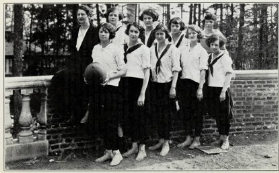By Colin Ehrman
Staff Writer

The year is 1923, and the doors of R.J. Reynolds High School have been flung wide open, inviting the public to the newest and freshest school in Winston-Salem. Now, in 2025, RJR celebrates 102 years of existence as one of the most historic and best arts schools in North Carolina. However, in a constant celebration of RJR’s rich history as an excellent art school, the athletics department has never failed to bring success. Championship glory has been woven into the history of RJR, and to this day, they remain at the forefront of WSFCS athletics. But through all these championships, one remains unclaimed, dating as far back as RJR’s opening. But the reason why remains a mystery.
The 1923 Lady Demon basketball team, led by star forward Lake Lentz and her supporting cast of Josephine Huntley, Etta Terrell, and Lillian Cromer, RJR, had one of the best offenses in the state, propelling them to a 7-5-3 record and as well as a state title. While traveling all over the state, RJR won game after game, closing their championship season in front of a sold-out crowd at the Greensboro YMCA on March 22, 1923. The Lady Demons basketball team would defeat Trinity High School 21-7, bringing the school its first state basketball title.
Throughout this fantastic season, the undisputed team MVP had to go to starting forward Lake Lentz, who dominated opponents, scoring over 170 points on the season. Looking back, it was an amazing first year for the Women’s Basketball program at RJR. A state championship in their opening season was nothing short of incredible. However, neither the state nor the RJR Athletic Department notes this championship as official, meaning the ‘23’ title sits Unclaimed.
The central reason the title remains unclaimed is because of the style in which the game was played. Before 1972, women were not allowed to play the classic five-on-five basketball game the modern world has learned to love. Instead, high school girls played six-on-six. The significant difference between the two styles is that the six-on-six game is played on a half-court, as players are restricted from crossing the mid-court stripe while three guards defend three forwards. At the time, this version of the game was considered “better” for women and was designed to have less competition with the men’s game. Following the Title IX federal law, established in 1972, schools were required to offer similar educational and athletic opportunities to men and women, meaning women were allowed to play the traditional five-on-five basketball style.
In 102 years of the RJR women’s basketball program, the only state championship they’ve brought home was the title from 1923. Following the Title IX law in 1972, RJR has yet to win the state championship. So this raises an important question. Is RJR failing to recognize a monumental championship because they won it in a style that is now deemed invalid? Is the state making them? Even when high school girls were forced to play a different way? Because it was “better” for them? Unfortunately, this is one hundred percent the case. The state of North Carolina is preventing the success and, more importantly, the history of RJR and its female sports programs by not recognizing this championship. In a day and age where recognizing women in sports is a significant piece of the social world, failing to bring light on this championship might not be the best look for the state. Now, is the case for other schools? That is uncertain.
While the 1923 R.J. Reynolds Women’s Basketball team marks an incredible accomplishment for the school and an amazing season that is not often discussed, it brings many other controversial issues to the table. Whether the state fails to recognize this title for a valid reason or not, it’s essential to discuss this. This way, the history does not remain a mystery.